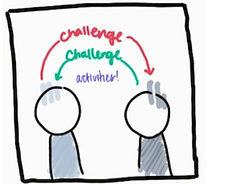
September 2020 - December 2020
MOODSCAPE: MOODBOARDING FOR MENTAL HEALTH APP
As part of an independent interaction design project I created a platform for people suffering from isolation especially during COVID to express themselves through moodboarding. Using UX Research & Design methodologies, I made personas, user stories, conducted competitive analysis, user interviews, and made low-fi and high-fi prototypes for the final product.
PROJECT TYPE: Interaction Design
ROLE: Individual project, UX Researcher & Designer
SKILLS & TOOLS: Competitive Analysis, Sketching, Storyboarding, User Interviews, Persona Development, User Flow Diagrams, User Testing, Adobe XD

THE PROCESS

FRAMING THE PROBLEM
THE BIG PROBLEM: Being isolated during coronavirus may lead to an increase in mental health issues such as anxiety, sadness and depression which can affect the day-to-day moods of those affected.
GOAL: To create a platform to combat feelings of loneliness and isolation and stress and facilitate peer emotional support to those who feel lonely, sad, or vulnerable during COVID-19 shelter-in-place order or have to self-isolate especially during the pandemic.
TOOL/SYSTEM :MoodScape: A mood board mental health app to create & share mood boards that capture moods, thoughts and emotions that give an outlet to express and vent your frustrations to improve mental health.
NEEDFINDING
By conducting Needfinding interviews I was able to identify key issues to address on my platform from people around me, including peers, acquaintances and classmates.
I started off feeling fine about taking classes from home because it was super convenient but then I realized that there is no interaction with others.
"
"
I definitely feel a lot more lonely the last few months, there are a lot more days where I’m just like blah
"
I think that with this pandemic, many people are suffering from low moods and I feel that people who do not have a proper support system
"
"
"

Through competitive analysis I learned about current products that are available that are similar to the application I had in mind. I researched their strengths, weaknesses and key brand differentiators that set the competitors apart.
FINDINGS
-
I found that there were no direct competitors for a mood-boarding mental health application. Most of the competitors revolved around interior design, architecture or creating color themes but nothing along the lines of mood-boarding for mental health.
-
Even the best and most popular platforms had weaknesses & drawbacks
-
Its important to be able to clearly and effectively differentiate yourself from existing platforms
COMPETITIVE ANALYSIS
PERSONAS
Each persona I created revolved around a main goal scenario that I wanted the application to address. Each persona was used to define the journeys for each type of user.
LO-FI PROTOTYPE
Using the user flow diagram as a guide, I began sketching out the basic layout of my prototype.
By physically drawing out each screen was able to visualize how users would navigate from page to page and what types of interactions would fall on each page.


I definitely feel a lot more lonely the last few months, there are a lot more days where I’m just like blah
WHAT I LEARNED
This was the first time working with wire-framing and prototyping software like Figma and Adobe XD which was an extremely valuable learning experience
Through this project I was able to understand both User research and User design aspects of ideation and creation of a product with specific goals
I am so excited to learn even more about user research and design and be able to implement new methods to present information in the most effective ways
SKETCHES
SKETCHING
After determining potential needs, I brainstormed 8 potential solutions that users could utilize to reach the main goals. I tried to focus on the most important features that could address the goal of the application.








STORYBOARDING
After sketching several potential ideas, I expanded upon each idea to include more context, perspective, and practical uses of the solution in user's everyday lives.












STORY MAP &
USER FLOW DIAGRAM
Based on the primary and secondary personas I created story maps on how each user would interact with my solution. Groupings were based on tasks and actions they would take to fulfill their specific user goal.
I then constructed a general story map based on all the personas and constructed a user flow diagram that can be used to navigate my solution's interface. I focused on integrating small interactions seamlessly into a common user flow.



FINAL PROTOTYPE
Using Adobe XD I created the final prototype of my solution.



Note! Has Sound!


